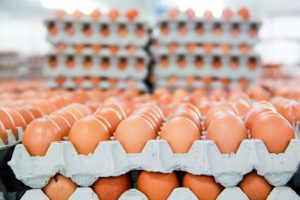
Ukraine International Airlines (UIA) has been permitted to transport dangerous goods of six categories from the Chinese aviation authority, the airline has said.
The license gives UIA the right to transport to/from China consumer goods, which are specified as “Dangerous Goods.” These are smartphones, computers, tablets, photo cameras and other electronical items of well-known world brands, which are produced in China.
“It took us over three years for receiving the license, during this time the company was subject to numerous thorough checks by the Chinese Aviation Authority. As a rule, China checks the reliability of the carriers who are going to transport the goods specified as “Dangerous Goods” very scrupulously. Now all the formalities are finalized, UIA has new opportunities for organizing the transportation of consumer goods on non-stop flights Kyiv – Beijing – Kyiv by wide-body long-haul Boeing-777 aircraft,” Peter Kukharchuk, UIA Logistics and Cargo Director, said.
He said that UIA was among the first ones to receive a license for transportation of several categories of dangerous goods, gives us significant competitive advantages.
UIA received a license for transportation of dangerous goods of categories 2, 3, 5, 6, 8 and 9 from China.

Ovostar Union, one of the leading egg and egg products producer in Ukraine, in January-March 2019 saw $4.5 million in net profit, which was 38.7% more than a year ago.
According to a company report on the Warsaw Stock Exchange (WSE), revenue fell by 8%, to $31.14 million. This is linked to the decrease in the egg and egg products prices.
Gross profit in January-March fell by 30%, to $7.82 million, and operating profit – by 47.4%, to $4.57 million.
Export sales over the period grew by 24.8%, reaching $18.02 million. The share of export grew from 43% to 58%.
Earnings before interest, taxes, depreciation and amortization (EBITDA) fell to $5.4 million ($9.5 million in January-March 2018).
“The first quarter of 2019 proved to be challenging for the egg industry due to the reduction of selling prices both on local and export markets. With regard to the unfavorable market situation, the management believes that the results achieved by the company in the reporting period are quite satisfying,” CEO Borys Bielikov said.

Rubizhne cardboard packaging mill in Luhansk region, one of Ukraine’s largest cardboard packaging producers, produced 81.05 million square meters of corrugated cardboard boxes in January-April 2019, including goods from its Trypilsky packaging plant, which is 2.6% up year-over-year.
The UkrPapir association said that the mills decreased production of components of corrugated cardboard (cardboard and fluting) by 22.3%, to 76,000 tonnes.
The total commodity amount produced by both plants in the period in monetary terms fell by 12.8%, to UAH 1.565 billion.
According to UkrPapir association, cardboard packaging production in Ukraine in January-March 2019 fell by 3.6% and amounted to 319.8 million square meters.
The Rubizhne cardboard packaging mill has worked on the packaging market since 1991, and specializes in the production of components for corrugated cardboard (cardboard and fluting) and corrugated cardboard boxes.
Its most important customers are large confectioneries, juice and tobacco producers.
The Rubizhne cardboard packaging mill acquired Trypilsky packaging plant in 2002 and subsequently began producing corrugated cardboard and corrugated packaging.
CARDBOARD, CORRUGATED BOXES, LUHANSK REGION, PACKAGING, RUBIZHNE

The 8th International Conference UKRCEMFOR 2019. Cement industry. Best Practices. Prospects for Development with a focus on highlighting the important aspects of cement industry will take place on May 28-29, 2019 in the Champions Hall of the Olimpiyskiy NSC in Kyiv. Conference Organizer: UKRCEMENT Association of Cement Producers of Ukraine. Partners: Ivano-Frankivskcement, CRH, Dyckerhoff-Buzzi, Heidelberg, Eurocement, DALGAKIRAN COMPRESSOR UKRAINE, FLSmidth and industrial construction group KOVALSKA.
Conference is the largest cement industry event in Ukraine which biennially brings together about 300 high-ranking delegates of companies and organizations from more than 10 countries.
Сement industry remains a solid, stable and growing part of the national economy. Represented by 4 large international groups – CRH, Dyckerhoff-Buzzi, Heidelberg, Eurocement, and a strong Ukrainian company Ivano-Frankivskcement, the local cement industry is well balanced and grows sustainably for the third consecutive year.
UKRCEMFOR 2019 for the 8th time will become a unique communication platform with owners and managers of all cement companies of Ukraine, cement consumers, manufacturers of concrete and concrete mixtures, manufacturers of impurities in concrete, construction companies, trading companies, manufacturers of equipment for cement production, suppliers of services and materials, scientists, Ukrainian and international experts in the fields of economy, ecology, technology and quality, banks and funds investing in cement industry and construction, public sector.
Topics for discussion during the Conference:
– Current state and development trends of the cement industry: technology, equipment, and logistics
– Energy efficiency and ecology. Alternative fuels
– Cement-concrete technology and equipment in highways construction
– Standards and regulations in cement industry
– Quality and safety of construction materials
– Concrete, concrete products and equipment. City architecture and urban spaces
These and other topics to be discussed at the UKRCEMFOR 2019 between a solid body of delegates from within the industry, and panels of Ukrainian and international experts in economy, ecology, technologies and quality, as well as banking and finance.
Among the companies that have already confirmed their participation are: Thyssenkrupp Industrial Solutions AG, MC Bauchemie Ukraine, AUMUND Fördertechnik GmbH, GEOCON GmbH & Co. KG, Compressors International LLC, Schenck Process Ukraine, Schenck UK, Promtekhservis Ltd., Dalgakiran compressor Ukraine, Refratechnik Cement GmbH, IZOMAR-POLREF and others.
General Media Partners: TV Channel – PRYAMIY, Information Agency “Interfax Ukraine”, KORRESPONDENT magazine.
Media Partners: DENGI magazine, Prof Build, Cement International, Cement and its application magazine, ECOBUSINESS. Ecology of Enterprises, International Cement Review, Aspects of Construction, Commercial Property, Inventor and Rationalizer, Building Magazine, Concrete&Asphalt, Capital Construction, Construction Expert Newspaper, Build Portal, ProfiDOM, Industry in Focus, Gazeta.ua and Obozrevatel, Kiyv Post, National Industrial Portal.
Supported by: American Chamber of Commerce Ukraine, European Business Association, Ukraine International Chamber of Commerce, German-Ukrainian Chamber of Commerce and Industry, Confederation of builders of Ukraine, CEO URE CLUB, Taxpayers Association of Ukraine, The British Ukrainian Chamber of Commerce, Polish-Ukrainian Chamber of Commerce, Ukrainian Logistics Alliance.
Conference venue: the Champions Hall of the Olimpiyskiy NSC in Kyiv (Velyka Vasylkivska str. 55)
Participation is possible for TOP managers only. Registration is available till 12.00 PM May 26, 2019.
Online registration, agenda and other information are available at the Conference webpage: http://ukrcemfor.com/en
For embassies and media – free of charge (after confirmation). Participation is available for C-suite level representatives only.
Media accreditation by tel +38 044 383-07-22, +38 067 930-06-69, pradvice@ukr.net (contact person: Mila Shykota)

The Ukrainian company SolarGaps, which developed blinds with integrated solar panels, has won The Smarter E AWARD 2019 tender for energy transition solutions in Munich, the press service of the public organization Greencubator has reported.
The project won the nomination Smart Renewable Energy in the tender of the innovation hub The Smarter E, whose activities are aimed at the development of industry solutions.
Earlier, SolarGaps won the Climate Innovation Vouchers program of the European Bank for Reconstruction and Development (EBRD), and also received EUR1 million from the European Union’s framework program for the development of research and technology Horizon 2020.
Energy transition is transformations in the energy sector aimed at reducing the share of consumption of fossil fuels.